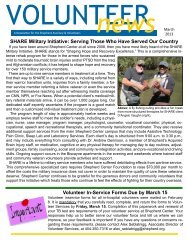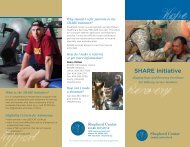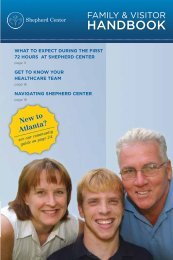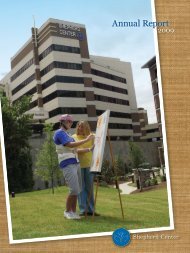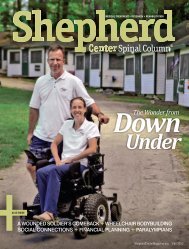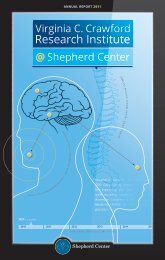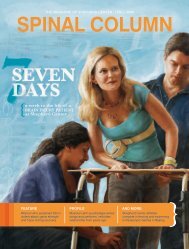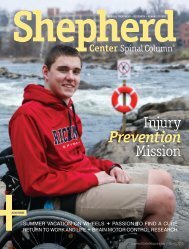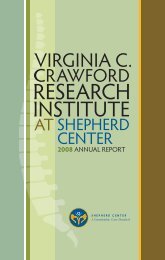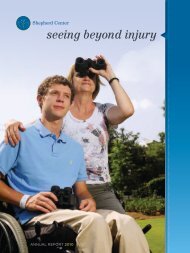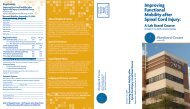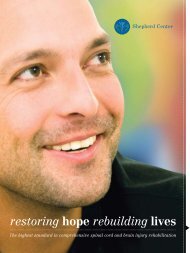the BRAIN - Shepherd Center
the BRAIN - Shepherd Center
the BRAIN - Shepherd Center
Create successful ePaper yourself
Turn your PDF publications into a flip-book with our unique Google optimized e-Paper software.
“Sixty to 70 percent of <strong>the</strong>se patients end up getting into a regular<br />
rehabilitation program.”<br />
PREP also addresses <strong>the</strong> patient’s family’s concerns about caring<br />
for <strong>the</strong>ir loved one. “The physicians and ABI staff involve <strong>the</strong> family<br />
and educate <strong>the</strong>m about caring for <strong>the</strong> patient from <strong>the</strong> beginning,”<br />
Dr. Kaelin says.<br />
“From <strong>the</strong> first day we got <strong>the</strong>re, I was shocked to see a team<br />
here waiting for us,” recalls Joel’s mom, Nancy Rodriguez. “It was<br />
amazing. They checked him out and started to explain things to me.<br />
It was so calming <strong>the</strong> way <strong>the</strong> doctors talked to me, how thorough<br />
<strong>the</strong>y were in giving me test results, telling me everything <strong>the</strong>y were<br />
going to do.”<br />
After about two weeks in <strong>the</strong> PREP program, Joel emerged<br />
from <strong>the</strong> semi-comatose state he was in. Then he underwent<br />
<strong>the</strong>rapy in <strong>Shepherd</strong>’s inpatient program and continued rehabilitation<br />
in <strong>the</strong> post-acute residential program at <strong>Shepherd</strong> Pathways.<br />
Joel does not remember much of <strong>the</strong> first few weeks he spent at<br />
<strong>Shepherd</strong>. His perception of <strong>the</strong> time he spent in <strong>the</strong>rapy at<br />
<strong>Shepherd</strong> is skewed, and just a week or so into his <strong>the</strong>rapy at<br />
Pathways, he felt like he was ready to return home. Like many braininjured<br />
patients, Joel’s lack of insight into his injuries caused him to<br />
doubt his need for continued cognitive <strong>the</strong>rapy, Dr. Kaelin notes.<br />
But Joel’s mom knew it was best for her son to complete <strong>the</strong><br />
full continuum of care that <strong>Shepherd</strong> offers for people with brain<br />
injuries. “I have faith in this place,” Nancy says. “I wanted what was<br />
best for Joel, so we stayed until he was ready to be released. The<br />
people at <strong>Shepherd</strong> knew <strong>the</strong>re was still healing that needed to<br />
happen inside Joel’s brain.”<br />
At Pathways, Joel attended classes that challenged him to use<br />
cognitive reasoning and problem-solving skills. He also continued<br />
physical, occupational and speech <strong>the</strong>rapy, and participated in<br />
group and individual counseling. Joel worked to regain function<br />
in his paralyzed left arm and leg. He can walk short distances<br />
with some assistance now, but continues to use a wheelchair for<br />
longer walks.<br />
One thing he particularly enjoyed during his <strong>the</strong>rapy was<br />
playing Wii video games that helped improve his eye-hand<br />
coordination. He also kept in touch with his friends back home,<br />
some of whom visited him at <strong>Shepherd</strong>. And Joel imagined <strong>the</strong><br />
things he’ll do as he continues to recover.<br />
“I could dance really good,” Joel says. “I ought to get out of this<br />
chair and show you how good. I could run fast and liked playing<br />
basketball and football. I can’t play those now. Maybe later. I<br />
hope in a year or so. I think I’ll have everything back.”<br />
Sary Newman, a physical <strong>the</strong>rapist at Pathways, believes Joel<br />
will indeed be back to his old self in time.<br />
“From a physical standpoint, his prognosis is good,” she says.<br />
“But he’s not seeing <strong>the</strong> big picture right now and is frustrated.<br />
That can take a while – maybe a couple of years. But he’s got a<br />
great family who loves him, and he’s getting good care.”<br />
SHARE Initiative<br />
Smiles don’t flow easily from <strong>the</strong> face of 22-year-old U.S.<br />
Army Specialist Greg Hutchinson – even now, with his whole<br />
life ahead of him. The horrors of war are still very much a part<br />
of him. But thanks to <strong>the</strong> SHARE Initiative at <strong>Shepherd</strong><br />
<strong>Center</strong>, <strong>the</strong>y are no longer <strong>the</strong> sole defining statement of who<br />
he is or who he can become.<br />
“Six months ago, I couldn’t make it out to lunch,” Greg says.<br />
“I’m a totally different person now. I have a different outlook.<br />
Six months ago, if you were wearing a jacket, I’d be wondering<br />
Photos by Gary Meek<br />
8 Spinal Column w w w. s h e p h e r d . o r g



